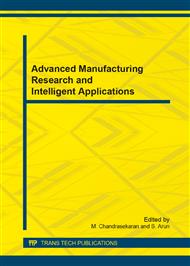[1]
H. Demir and S. Gunduz, The effects of aging on machinability of 6061 aluminium alloy, Materials and Design, 30 (2009), p.1480–1483.
DOI: 10.1016/j.matdes.2008.08.007
Google Scholar
[2]
F. Ozturk, A. Sisman, S. Toros, S. Kilic and R.C. Picu, Influence of aging treatment on mechanical properties of 6061 aluminum alloy, Materials and Design, 31 (2010), p.972–975.
DOI: 10.1016/j.matdes.2009.08.017
Google Scholar
[3]
F. Oztur, E. Esener, S. Toros and R.C. Picu, Effects of aging parameters on formability of 6061-O alloy, Materials and Design, 31 (2010), p.4847–4852.
DOI: 10.1016/j.matdes.2010.05.050
Google Scholar
[4]
D. Maisonnette, M. Suery, D. Nelias, P. Chaudet and T. Epicier, Effects of heat treatments on the microstructure and mechanical properties of a 6061 aluminium alloy, Materials Science and Engineering, A 528 (2011), p.2718–2724.
DOI: 10.1016/j.msea.2010.12.011
Google Scholar
[5]
Narayanasamy. R, M. Ravichandran and N.L. Parthasarathi, Effect of annealing on formability of aluminium grade 19000, Materials and Design, 29 (2008), p.1633–1653.
DOI: 10.1016/j.matdes.2006.12.019
Google Scholar
[6]
V. Mugendiran, A. Gnanavelbabu and R. Ramadoss, Tensile Behaviour of Al5052 Alloy Sheets Annealed at Different Temperatures, Advanced Materials Research, 845(2014), pp.431-435.
DOI: 10.4028/www.scientific.net/amr.845.431
Google Scholar
[7]
Nader Abedrabbo, Forming of aluminium alloys at elevated temperatures – Part 1: Material Characterization, International Journal of Plasticity, (2006), p.314 – 341.
DOI: 10.1016/j.ijplas.2005.03.005
Google Scholar
[8]
C. Loganathan, R. Narayanaswamy and S. Sathiyanarayanan, Effect of annealing on the wrinkling behaviour of the commercial pure aluminium grades when drawn through a conical die, Materials and Design, 27 (2006), p.1163–1168.
DOI: 10.1016/j.matdes.2005.02.016
Google Scholar
[9]
D Li and Amit Gosh, Tensile Behaviour of Aluminium alloys at Warm forming temperatures, Materials Science and Engineering, (2002), p.279 – 286.
Google Scholar
[10]
Jun Liu and Ming-Jen Tan, Formability of AA5083 and AA6061 alloys for light weight applications, Journal of Materials Design, (2009), pp. S66 – S70.
DOI: 10.1016/j.matdes.2009.10.052
Google Scholar


